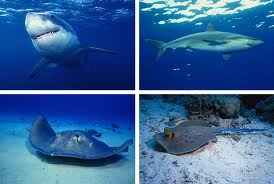What are Cartilaginous Fish?
1. What makes cartilaginous fish different from other fish? Give examples.
Skeletons made of cartilage, an example is the heart and blood.
2. List examples of cartilaginous fish.
Skates, Chimaeras, rays, bull sharks, banjo shark.
3. What is special about the sharks eye?
They have muscles that cal roll the eye back into the socket for protection.
4. What are the differences between bony fish and cartilaginous fish:
a. Heart and Blood - Sharks have fewer red blood cells, Bony fish have a bone marrow for hemopoiesis.
b. External features - Shark skin is covered by dermal denticles. Bony fish are covered in flat scales.
c. Digesting and Evacuation - Bony fish have two seperate openings, a rectum and an anus. Sharks kidneys & genitals empty into only one opening called the cloaca.













